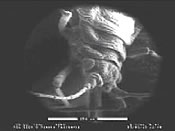Pest management team on the lookout for the exotic
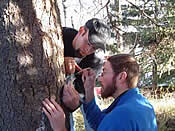
IPM Technicians Dan Lung and Michael Rasy collect insect specimens
from a spruce tree. Photo by Corlene Rose, IPM program manager.
Image courtesy of IPM staff.
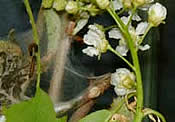
Image courtesy of IPM staff.
by Roxanne Creamer, Cooperative Extension Service
June 2003
In a global economy where ornamental trees, plants and other goods are shipped into Alaska from all over the world, the potential for non-indigenous, or exotics, pest species increases. In an attempt to detect the pests early on, the Integrated Pest Management team at the University of Alaska Fairbanks conducts field scouting each year. IPM technicians provide information about how to identify and control a wide variety of species which pose potential threats to Alaska’s forests and other ecosystems.
It’s a common-sense approach to achieving long-term management of pest problems with minimal impact on human health and the environment. Strategies may include the application of physical, cultural, mechanical, biological and chemical controls. A combination of the least toxic, most effective, economically sound and environmentally responsible options provide the public with a wide range of alternatives. IPM is a cooperative effort combining the resources of the UAF Cooperative Extension Service and the U.S. Forest Service. IPM staff assist several government agencies with pest monitoring, mapping and research.
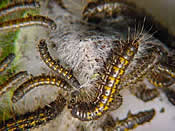
Image courtesy of IPM staff.
Western Tent Caterpillar
In May of 2003, IPM staff in Anchorage, with the assistance of the forest service entomologist, identified Malacosoma californicum, the western tent caterpillar, on ornamental tree stock recently shipped to Alaska. The hairy caterpillars, which are the larval stage of moths, feed in clusters within a silken tent while stripping the foliage of trees and shrubs. The caterpillar has the potential to impact both native forests and ornamental trees. The caterpillar feeds on a wide variety of deciduous host species, including aspen, willow, birch and cottonwood. If established, this pest can quickly build up enormous populations, leading to extensive tree damage and increased pesticide use.

Image courtesy of IPM staff.
Gypsy Moth Trapping
The Asian gypsy moth is a potential insect invader that could pose a serious problem in Alaska. These caterpillars feed on a broad range of more than 300 host species of both deciduous and coniferous trees.
Birch Aphids
Aphids can be recognized by their soft, pear-shaped body, long legs, and a pair of cornicles or tubular structures at the posterior end of the abdomen. They are sap-sucking insects with mouthparts developed for piercing plant tissues and extracting juices. The most common effects of heavy aphid feeding on birch trees are leaf discoloration and distortion, premature leaf fall, temporary growth reduction, and occasional dieback to branches.
Video(492K):
Aphid - An aphid at high magnification
using UAF’s environmental scanning electron microscope.
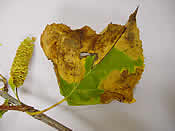
Image courtesy of IPM staff.
Amber-Marked Birch Leaf Miner
The amber-marked birch leaf miner Profenusa thomsoni, is an imported pest that infested birch trees in southcentral Alaska in the mid-1990s. The leaf miner was introduced from Europe into the Northeastern U.S. in the early 1900s. It was likely introduced into the Anchorage area through ornamental birch trees and because it has no natural enemies in Alaska, it has spread quickly infesting the area’s native birch. The distribution of the leaf miner in the Anchorage area is extensive. The pest was recently introduced into the Tanana Valley at Eielson Air Force Base. Damage to the trees, often seen as browning of the mined leaves, occurs late in the growing season. Tree mortality directly caused by leaf miner feeding has not been documented, but repeated heavy infestations can weaken birch. Unhealthy trees are more likely to be negatively impacted.
In 2002, IPM technicians in Anchorage assisted the forest service entomologist with insect trapping to monitor for a specific parasitic wasp, Lathrolestes luteolator (Hymenoptera: Ichnuemonidae), whose host species is the leaf miner. On a weekly basis, technicians emptied and replaced sticky traps on birch trees situated throughout the city in an effort to collect samples from a diverse range of insect habitats. The wasp species has been a successful biological control agent of the leaf miner in Edmonton, Alberta. The forest service is planning a three-year, cooperative, multi-agency program to introduce these wasps to the Anchorage area as a biological control of this pest.
For more information about:
- Noxious and Invasive Plants
- Invasive Weeds Awareness Week
- Integrated Pest Management Outreach, Programs and Specialties
More Pest Related Publications are available at the UAF Cooperative Extension Service



